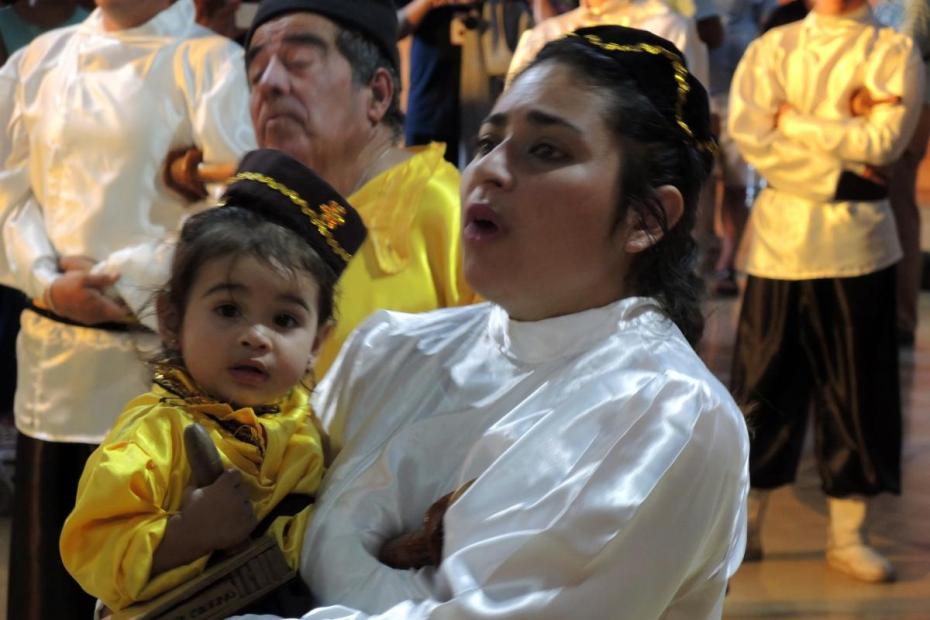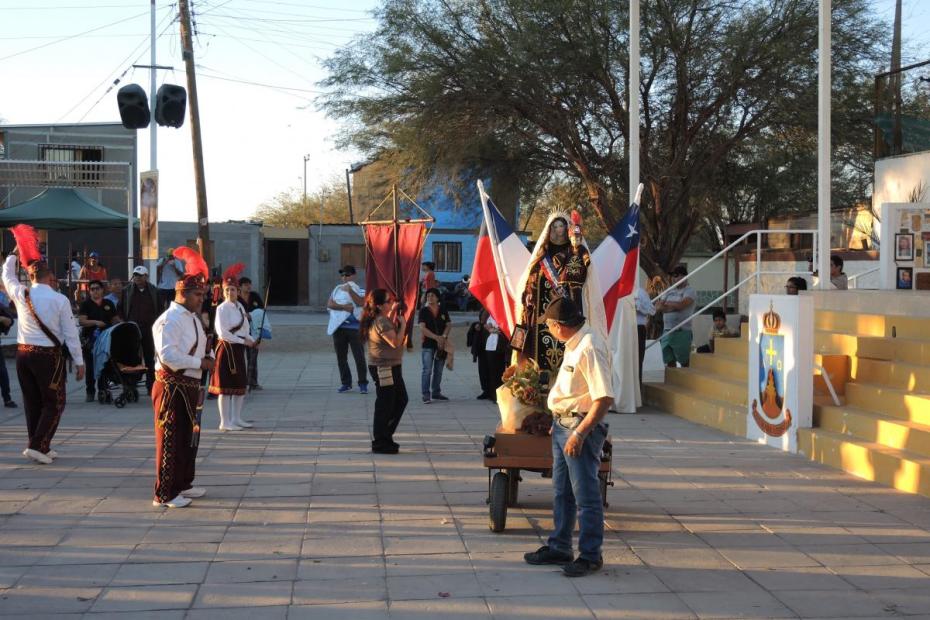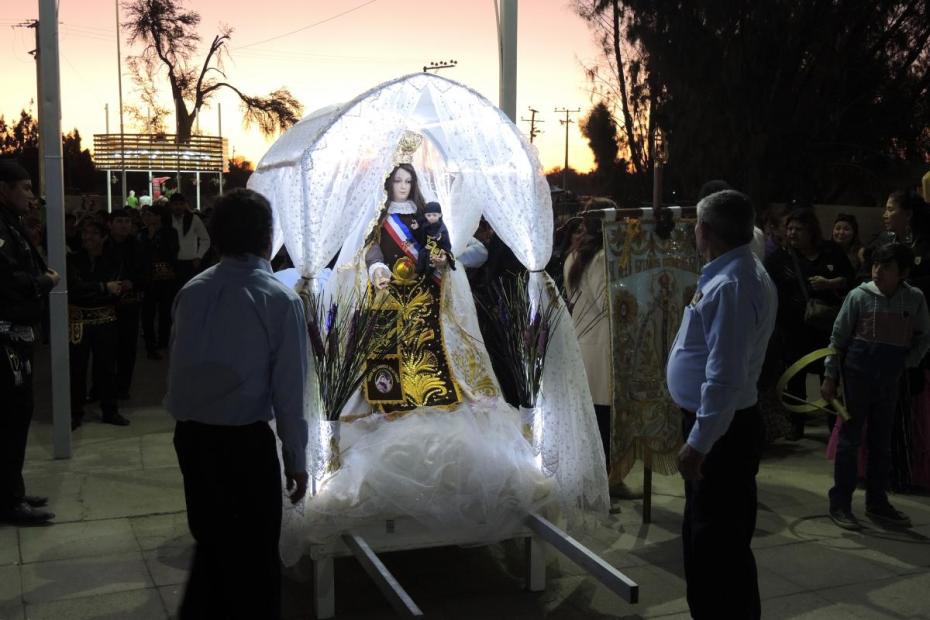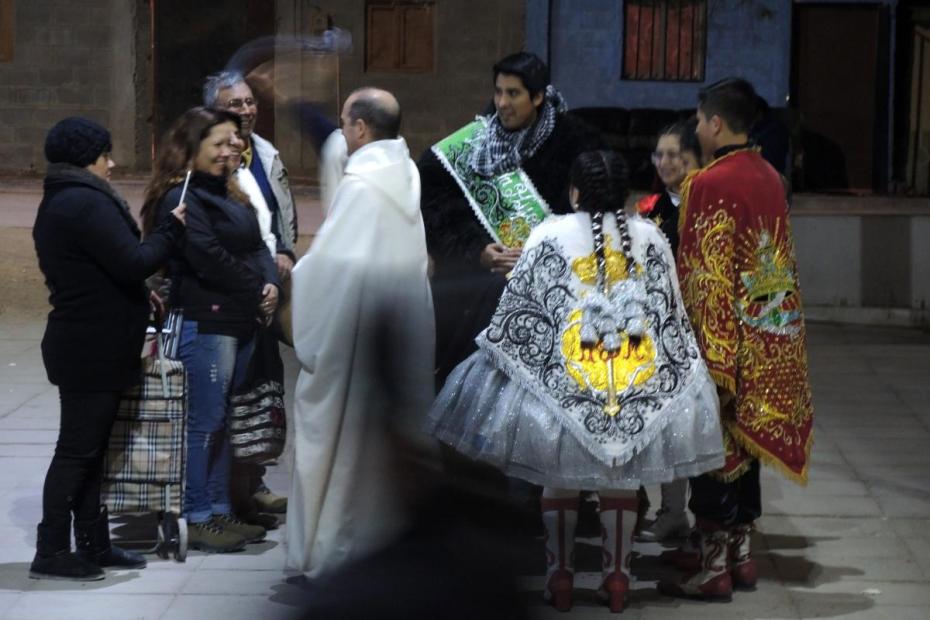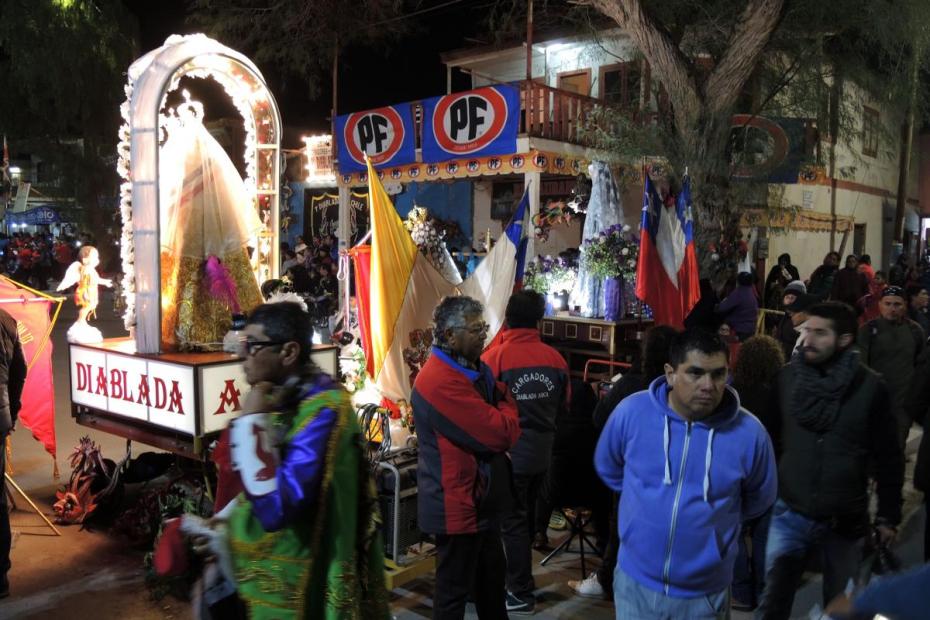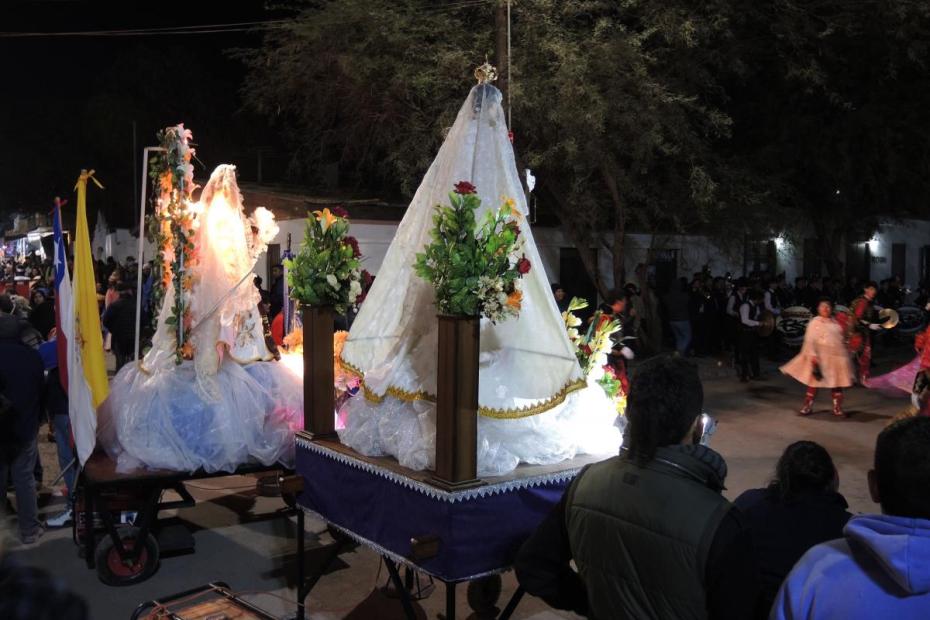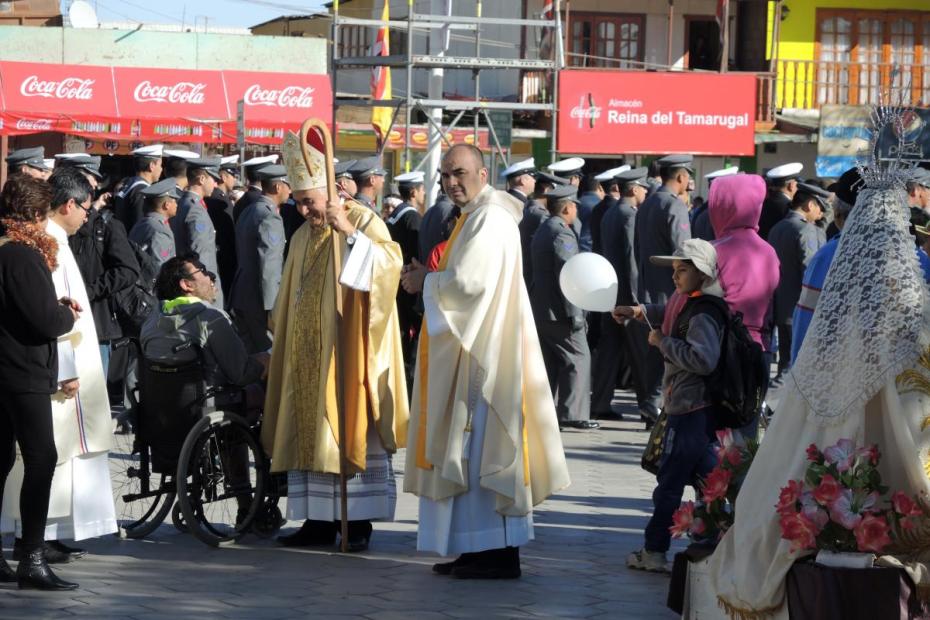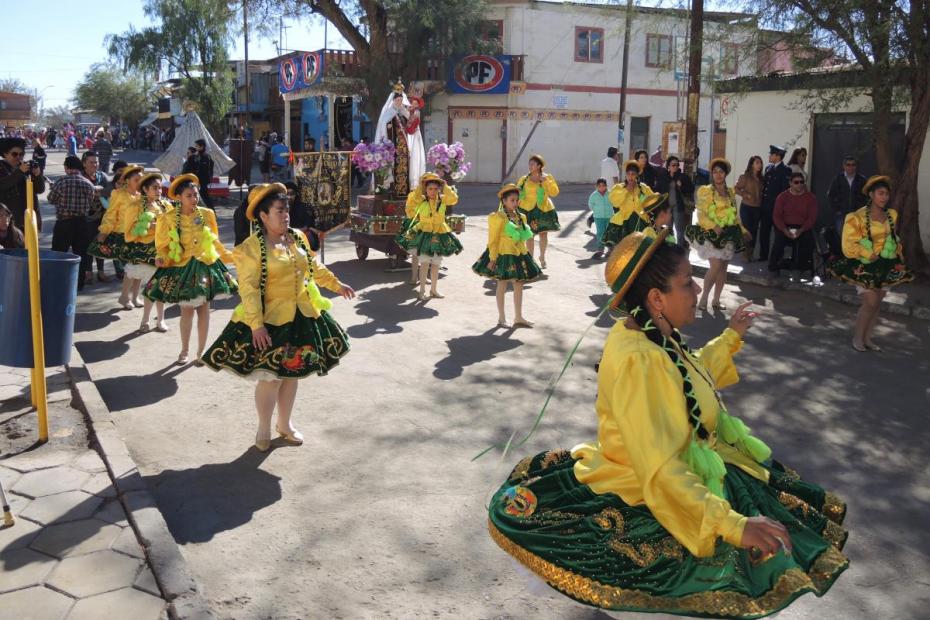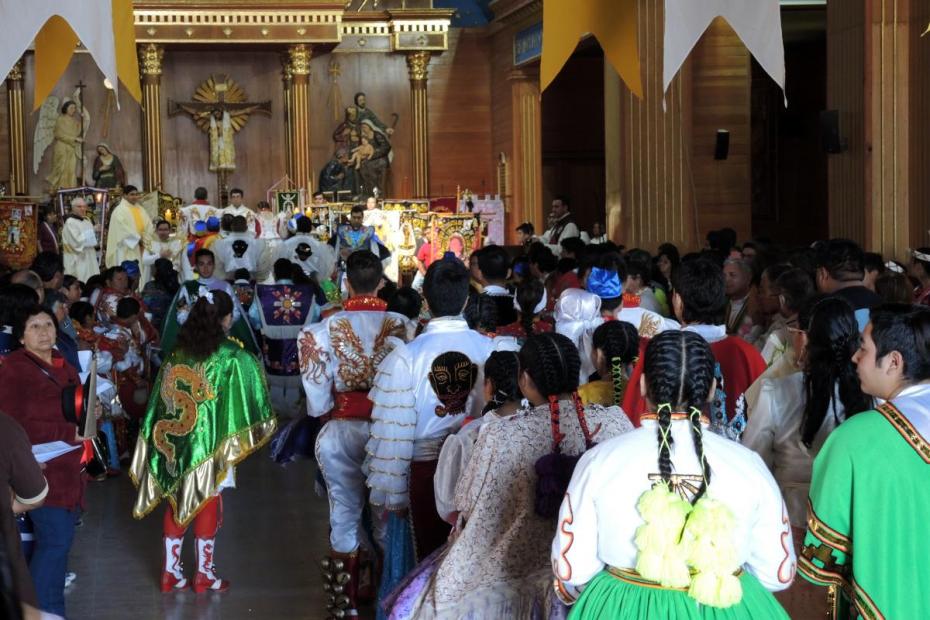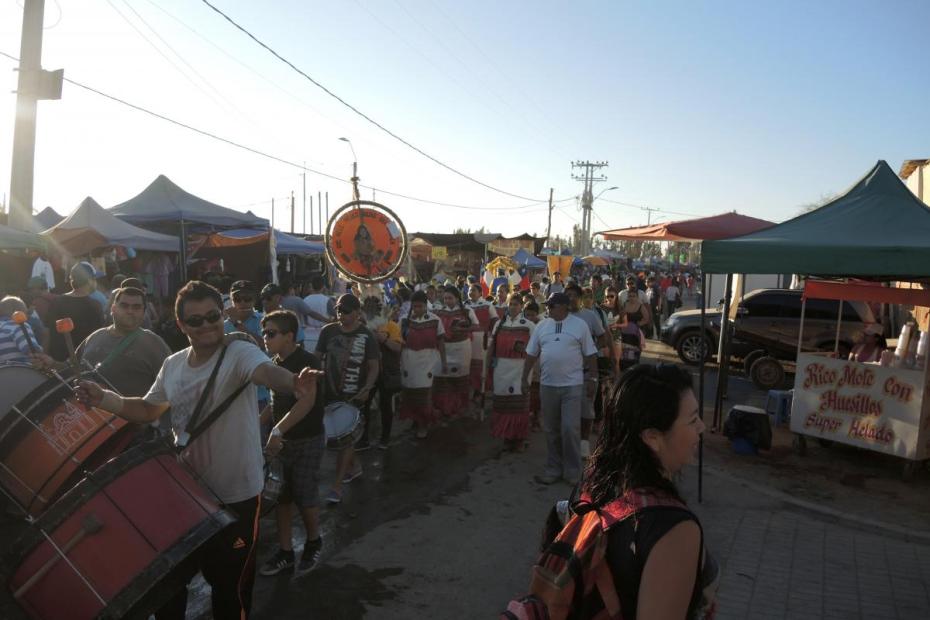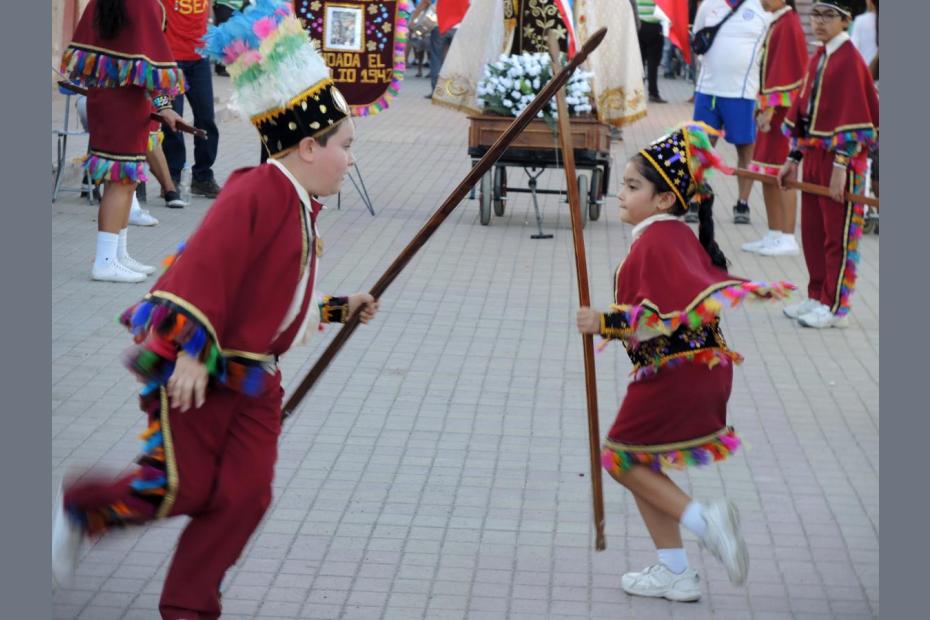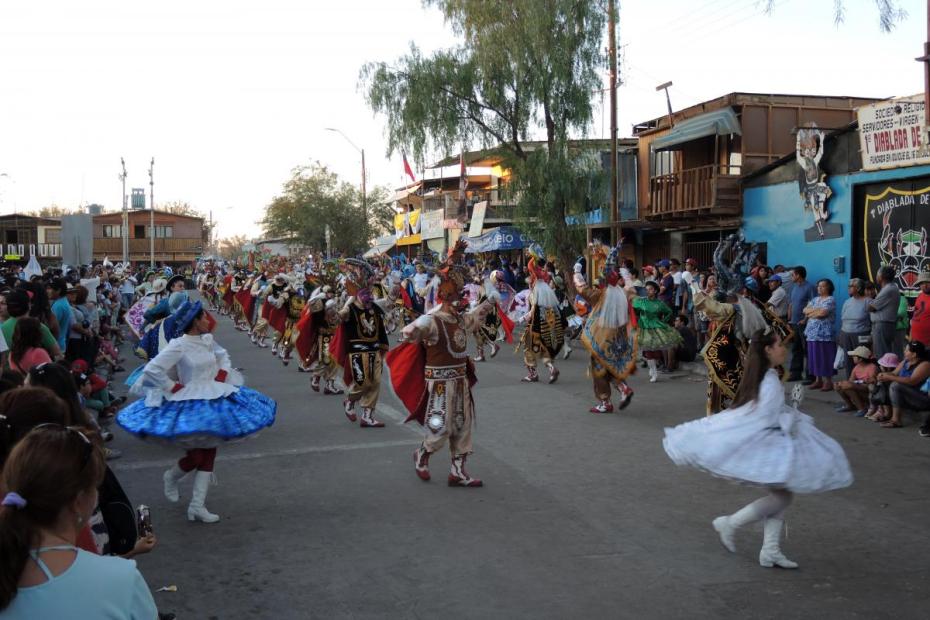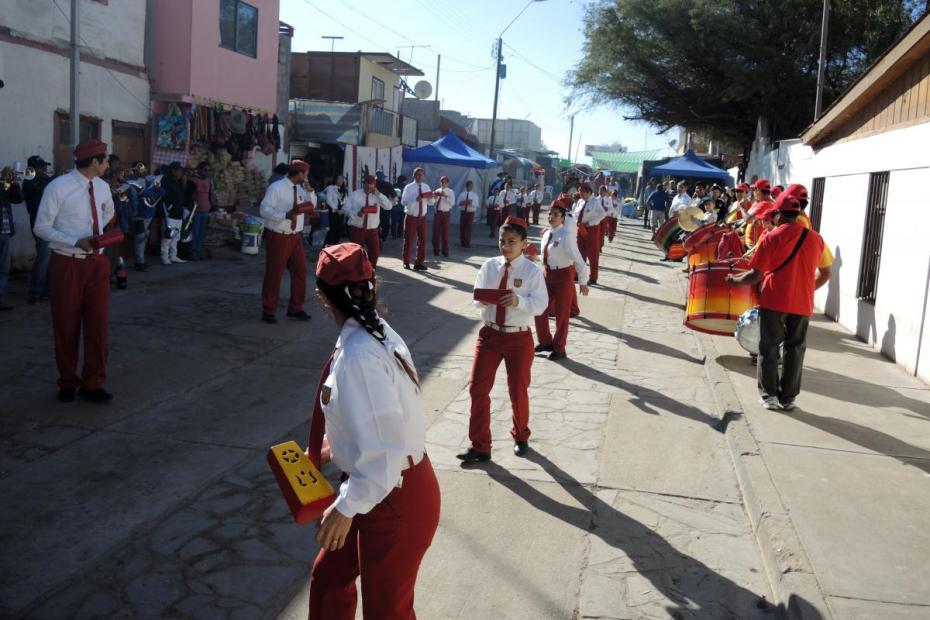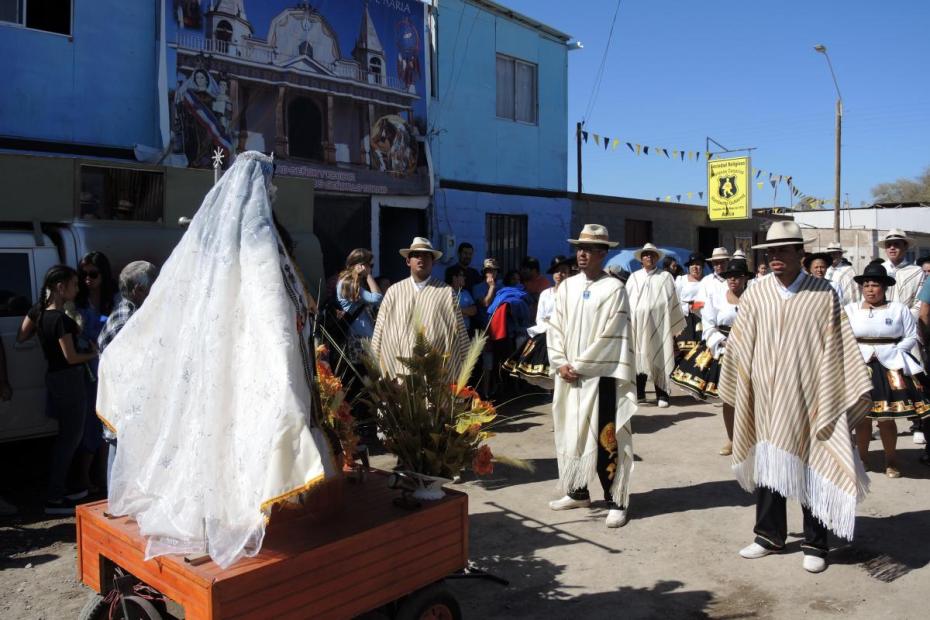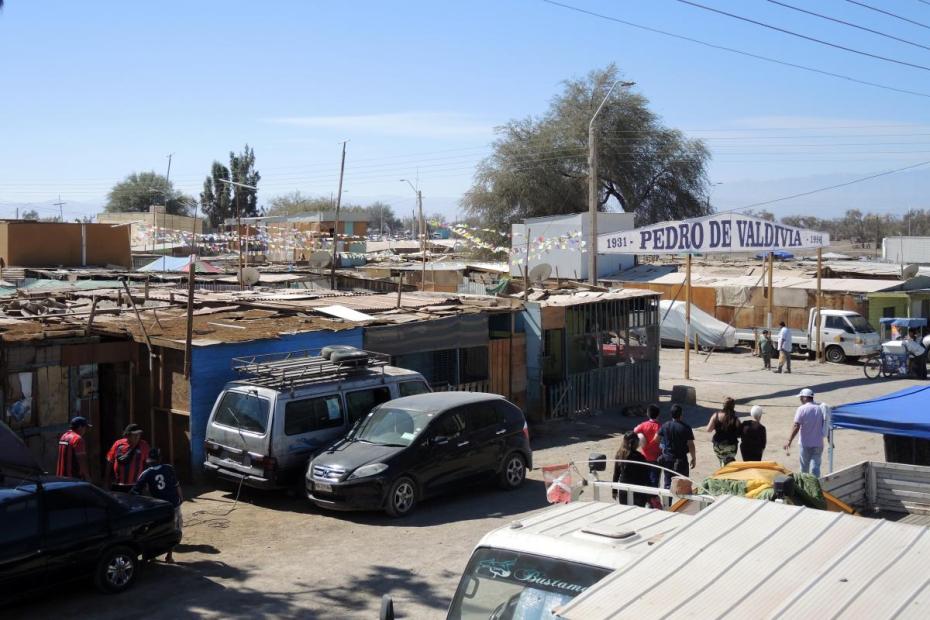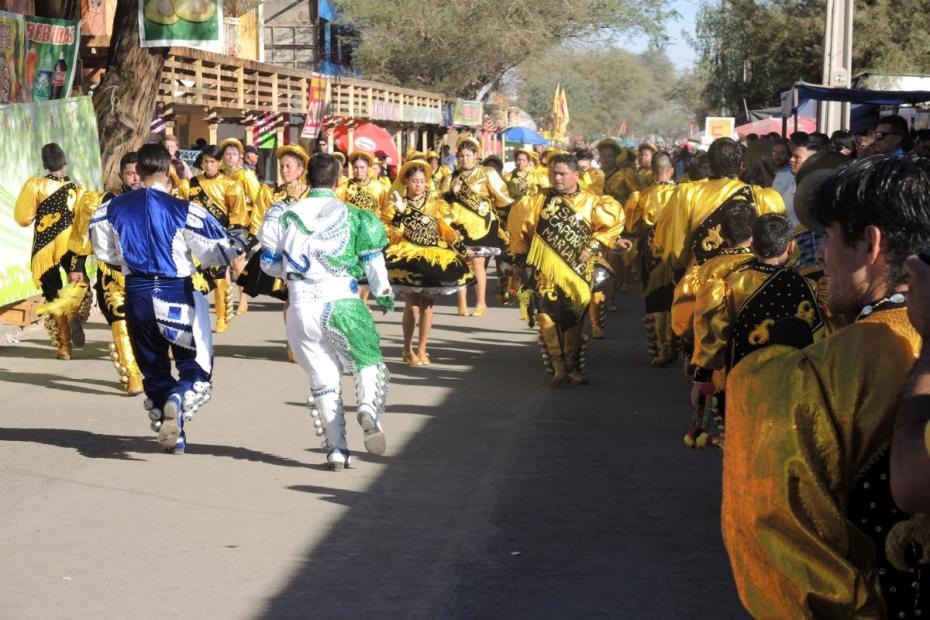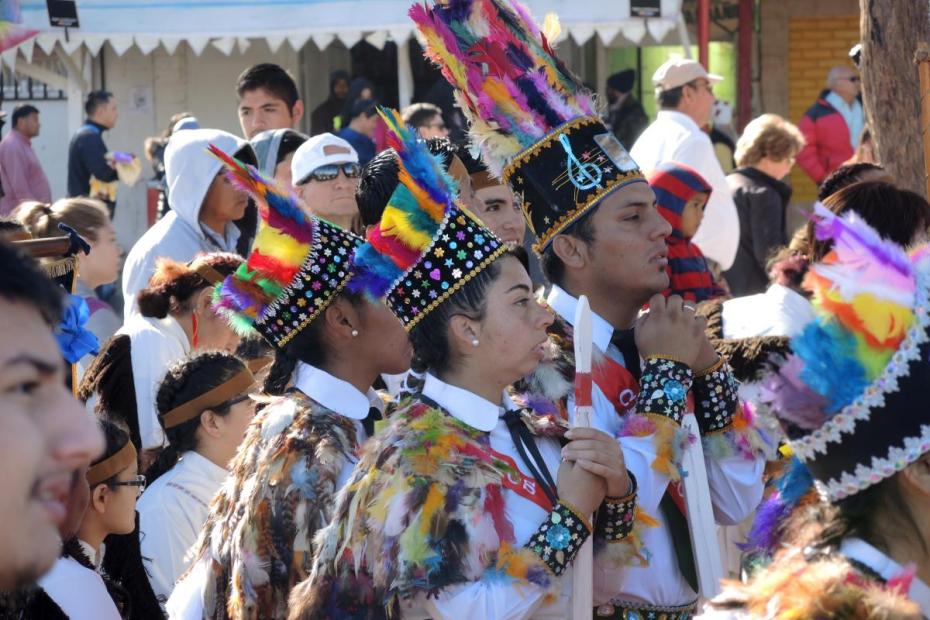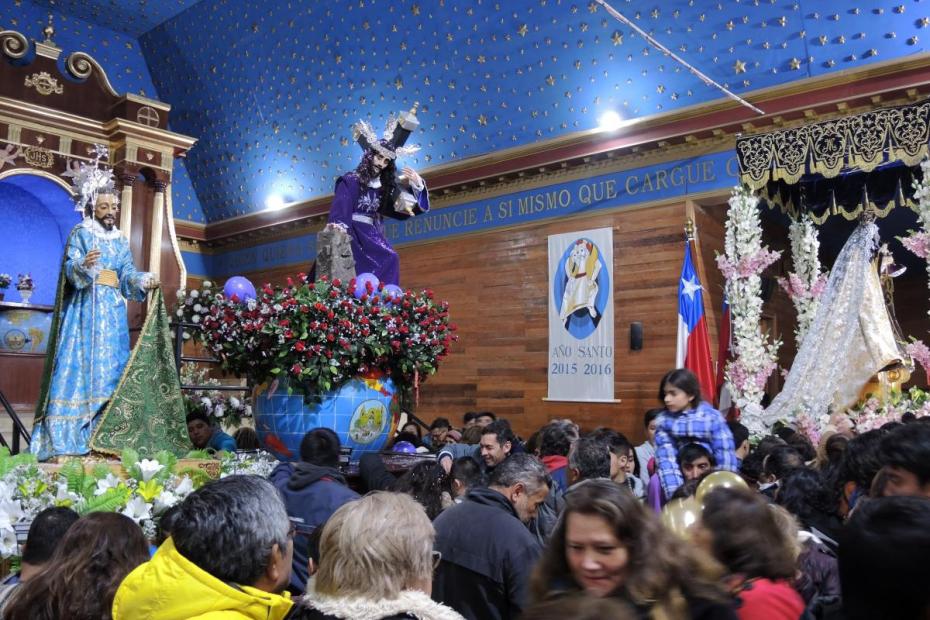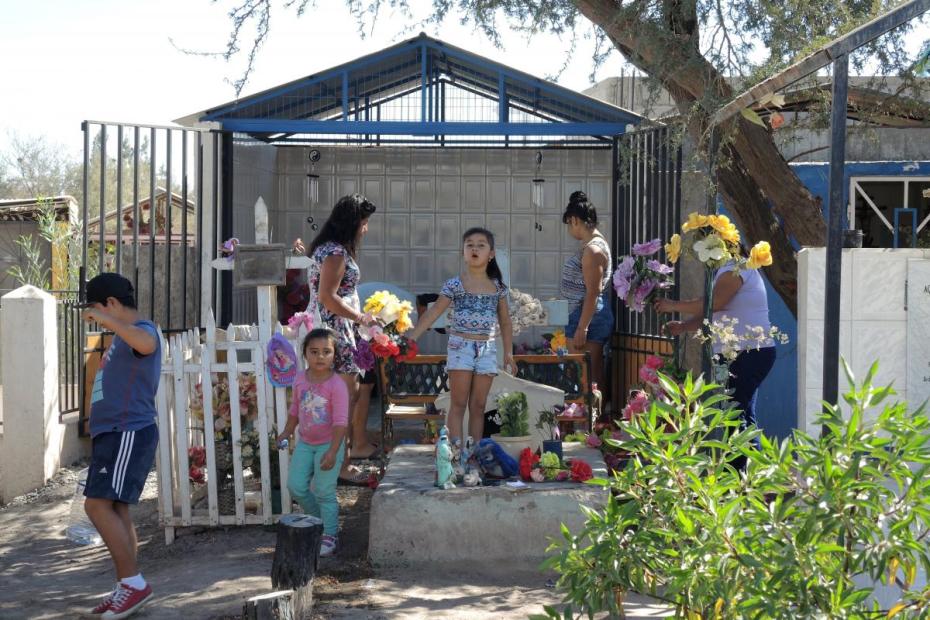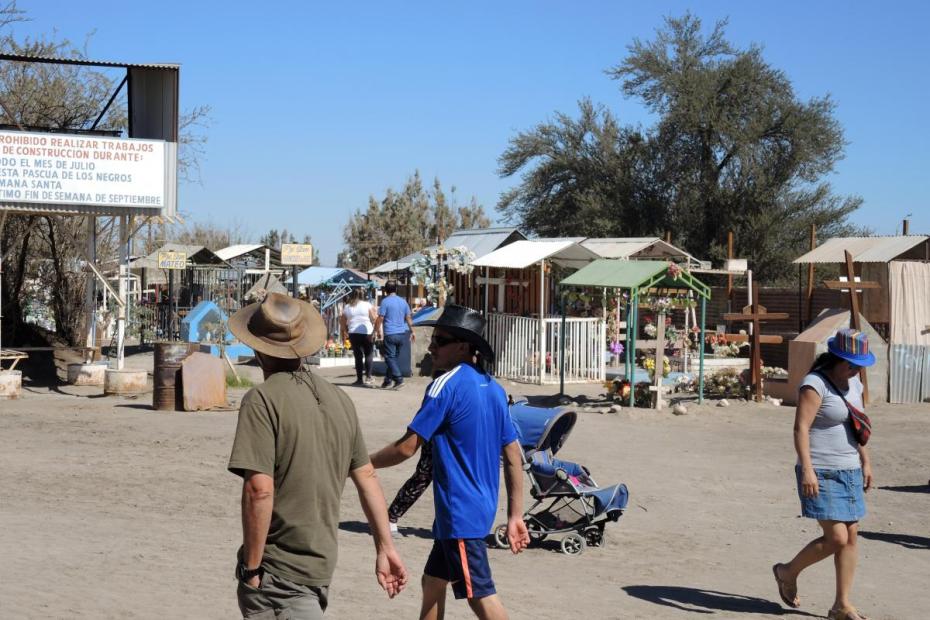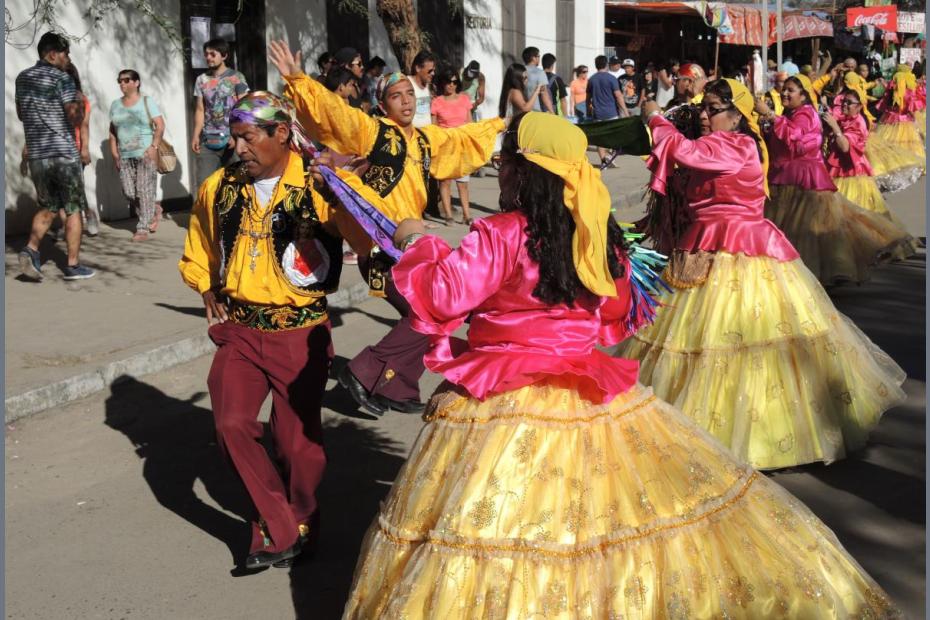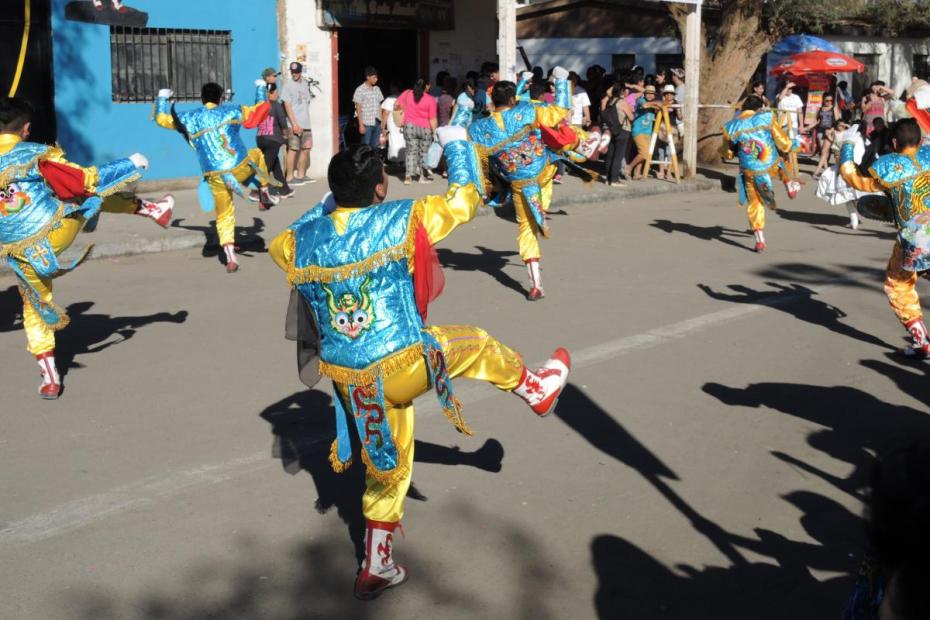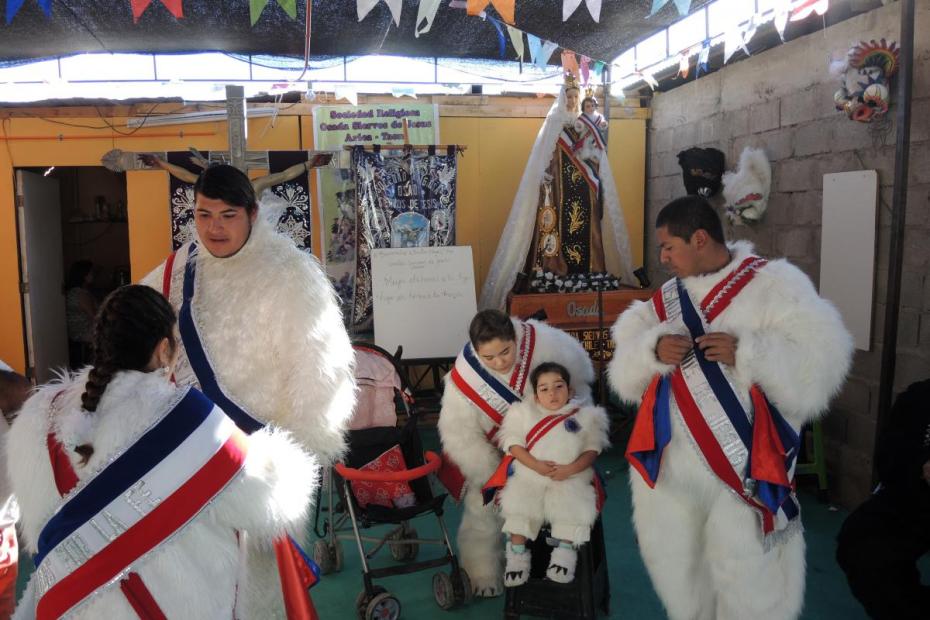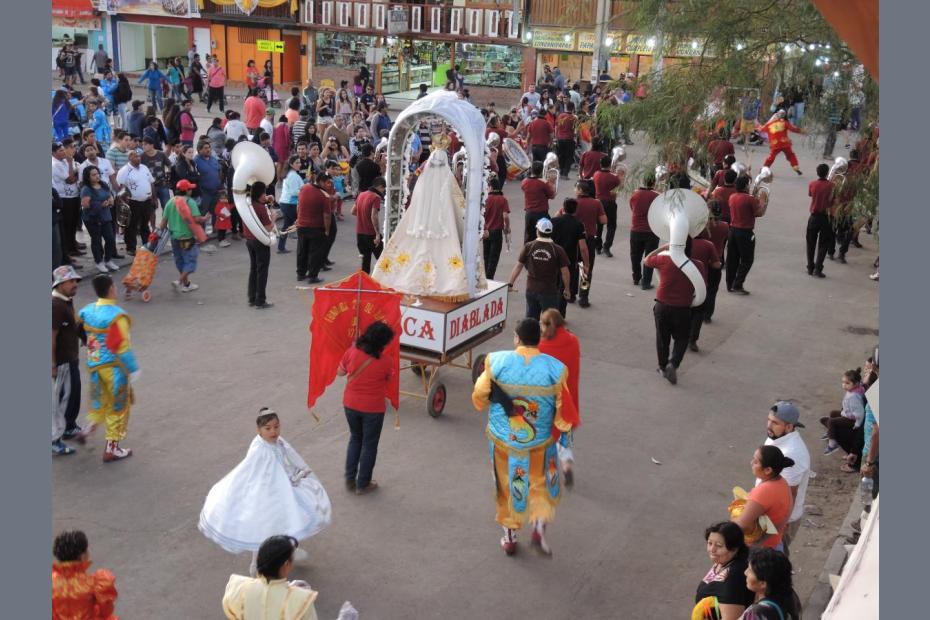The dance celebrations at La Tirana are organized around the feast day of the Virgen del Carmen, July 16. But the full schedule, from July 10-19, has a number of other high points that make it so meaningful to those who make the pilgrimage there.1 Even in the days before and after July 10-19, back in their home cities, there are special events for the dancers, including rituals beforehand to initiate the new dancers into the feast, and a less formal dance to the Virgin. A week after they return, the bailes, or dance groups, celebrate a fiesta chica, a smaller dance celebration that brings some of the experience of La Tirana back home.
Entry before the Virgin
While the groups’ experience at La Tirana begins with the setup of its hostel or camp, the entrada, or formal, danced entrance to the city and then the sanctuary, dressed in costume, is a huge high point for the dancers. Before the entrada, groups cannot dance elsewhere in the city, so that significant aspect of the feast has to wait. Moreover, going before the Virgin herself in the sanctuary to announce that they have returned to fulfill their promise to her is a major emotional experience on its own terms. With 197 official bailes, the entries take days, even when scheduled around the clock, except for a few hours off for Masses.
The doors of the “temple,” or sanctuary, at La Tirana are formally opened on July 10, and bailes make their entrada from July 11-14. Each baile is assigned a specific time for entry, and the same order applies for departure at the end of the week. The baile dances first at a plaza at the entrance to the town, in front of the statue of the Cruz del Calvario, or Calvary Cross. Normally there is a priest there to formally welcome and bless the group at the Cruz Calvario. From there, dance groups process dancing and singing through the streets and the main plaza to the sanctuary, where they have 20 minutes to dance before Nuestra Señora del Carmen.
The dancers, accompanied by the other promesantes in their group, enter the sanctuary behind their band, banner and anda-carried statue of the Virgen del Carmen. They bow first at the main altar, which has a smaller image of the Virgin above it, then to the statue of the Nazarene, Jesus carrying the cross, in the left transept. Then they turn the right transept, which has a large image of the Virgin, before whom they dance. This is a visibly emotional time for dancers. Their songs typically announce who they are (e.g. “we are gypsies”), and that they are back with joy after much sacrifice and distant travel, to come before their mother. As one author summarized it, “The principal themes of these hymns are: joy to be at the feast and to return to encounter the Virgin; thanksgiving and homage; the abnegation of the pilgrim; the confession of sins; prayer for pardon, blessing life and health; the pain and sadness of saying goodbye. One encounters cosmic themes as well: sun, moon and stars; sky and rivers; life and death…”2
During the feast, the bailes, or dance groups, have 20 minutes allotted for entry and farewell dances before the Virgin inside a sanctuary. These dances take place 24 hours a day, except during scheduled Masses, and take many days to complete.
When dancing at the entry (and later at the goodbye), dancers are supposed to, and do, pay attention to the image of the Virgin, not to the friends or other onlookers who watch them. The bailes do not expect perfect precision from the dancers. Though the dancers do not sing when they dance in the square, singing is an important part of the entry and exit. When leaving the entrada before the Virgin, dancers do so on their knees, shuffling out backward, and the next group follows in immediately.
After bailes have made their entries and become eligible to dance, the square and streets begin to fill with rows and rows of dancers and their bands, all lined up in front of their statue of the Virgin and the cloth standard of their society all night and day. Only during morning Masses in the sanctuary does the dancing in the square ever totally stop. At some point during the feast, each association celebrates a special Mass particularly for its members, with first communion for children. In a small chapel nearby, and at a larger chapel recently rebuilt on the site of the original church, weddings and baptisms are often celebrated for those who have prepared for these sacraments at home, but waited to celebrate them here.
After bailes have made their entries and become eligible to dance, the square and streets begin to fill with rows and rows of dancers and their bands day and night.
Dancing in the plaza and at each other’s encampment
At some point between the entrada and the despedida, the parallel goodbye, each baile hosts a formal visit from another baile. Within associations, bailes draw lots to select the matches. A visit entails the dance group coming in its trajes (special dance costumes) and dancing outside the compound or camp of the host baile. Then there are speeches of welcome and introduction. The host group serves a meal (the only time dancers can eat in their trajes), and the visiting group presents a gift of thanks to the hosts.
Bailes make scheduled visits to another baile at their compound. Wearing their trajes, or sacred costumes, they dance and sing before the hosting group's image of the Virgin and then the two groups share a meal.
Throughout the feast — including during Masses and while bailes are dancing before the Virgin — pilgrims of all sorts, both bailes members and those who just come in for the day from the cities, wait in long lines outside for a turn to enter the sanctuary at a special door that allows them to walk up and touch the Virgin’s dress. People also ask that religious objects, and even children, be passed up the stairs to be blessed by touching them to the Virgin’s clothes in the sign of the cross. Two to four volunteers are on hand 24 hours a day to help with those tasks.
'Like New Year’s': The eve and feast day of the Virgen del Carmen
Part of the day on June 15 is designated for visits to the cemeteries of deceased dancers who elected to be buried near La Tirana. The eve of the feast is a special time. In the early morning, the bishop celebrated Mass for representatives of the armed forces, whose patron is the Virgen del Carmen. By 9 p.m., the square begins to fill in anticipation of the midnight events that will welcome the feast of the Virgen del Carmen. The events can easily be compared to New Year’s Eve celebrations in many cities in the world, and many people there described this as their New Year’s, saying that their old year ended and a new one began that night. At 10 p.m., though it cannot come close to accommodating everyone in town, the square is packed for what is officially described as a “solemn” Eucharist and vespers, in anticipation of midnight. Worship certainly incorporates many solemn moments, but often it has the energy and excitement of a sporting event. At midnight, by which time temperatures have dropped near freezing, people are being led in calls of “Viva la Virgen del Carmen,” waving balloons, lighting flares and orange lanterns that float into the sky like tiny hot air balloons. The band near the outdoor altar plays music, and fireworks surround the city.
Following this, the crowds jostle toward sites set up by each association, where bailes take turns dancing in their trajes and singing the canto del alba, the song of dawn, a 10-minute greeting to their “mother,” the Virgen del Carmen. Celebrants stay up all or most of the night. Groups visit and socialize, sometimes sitting around small bonfires to keep warm.
The feast day for the Virgin of Carmen, Chile's patroness, is like New Year's Eve for those to come to dance for her in the desert town of La Tirana. After a solemn vespers, they will celebrate all night long with fireworks, dancing, and singing.
Even though many celebrants have stayed up all night, July 16, the feast day, is not simply a day for recovery. After sunrise, a small number of groups are still dancing in the square, and beginning at 9 a.m. crowds start to pack the square again for a major event, the lowering of a statue of the Virgin (the statue that is normally above the altar inside) from the roof of the temple onto a pedestal next to the large altar that has been set up outside. Hundreds of colored ribbons attached to the base of her pedestal are thrown out into the audience, extending the mantle of her dress into the audience. People hold the ribbons and sing, then celebrate as she is lowered into the square. Mass follows.
At 2:30 p.m., a procession of that image of the Virgin begins its way through the streets, preceded by statues of St. Joseph, her husband, and of Jesus bearing the Cross from the sanctuary. Each is carried on a large heavy anda, or carrying platform, borne by dozens of young men. At each block, one or more of the dance groups has the opportunity to sing to the Virgin, walking backwards in front of her in their trajes so that they do not turn their back on her. The bishop and some clergy and lay leaders walk in front of her, and crowds line the street and follow the procession, occasionally shouting “Viva La Virgen” and throwing confetti. She is processed around the entire periphery of the town and into the camps. The procession lasts at least seven hours, before it returns to the plaza and the temple, where a crowd awaits.
On the actual feast day, July 16, the attendees, many of whom have been up the entire night before, gather in the square for the lowering of the statue of the Virgin from the sanctuary to a platform to be processed around the town.
In the meantime, inside the temple, one of the associations has been accorded the honor of having its groups sing before the larger statue of the Virgen, which remains in the transept of the sanctuary. Crowds mob the church and move to create space for each group to sing. Though dancing is involved, it is notable that this is described as an opportunity to sing for the Virgin. A longer than usual line snakes outside the church for the chance to go up to the top of the steps and touch the Virgin, but others in the church pass up items and children to touch her dress.
Saying goodbye
Though the dance groups stay at La Tirana until July 19, the despedidas, the danced (and sung) goodbyes to the Virgin, begin by midnight after July 16. These mirror the entries in the temple, with music, bows at the main altar and to the Nazareno, dancing and singing. The despedidas can be even more emotional than the entradas. As they begin, the church is packed, though over time they are often accompanied primarily by their own friends and association members. Assigned to leave in the same order they arrived, dance groups take turns through the night saying goodbye. This continues, except during Mass times, 24 hours a day through July 19. Those in the group who have completed their manda, or promise, and don’t expect to dance next year, go up to the altar and remove part of their trajes. Many dancers are visibly crying. They leave the church shuffling backwards on their knees, so as not to turn their backs on the Virgin. During the early morning hours of 2016, as the bailes in the Asociación San José de Arica were leaving, one person fainted and was carried out by another dancer who remained on his knees. Occasionally dancers wailed in the back of the church as they departed
In a reversal of their original entry, dancers leave the church and process to the Calvary Cross, where they dance again. Some dance back at their camp briefly, a celebratory dance, they say, to take their minds off their grief. After this, they cannot dance for the rest of the feast.
A week after they depart La Tirana, they gather in their home cities for a fiesta chica, a follow-up dance to La Tirana that helps bring the joy and devotion of La Tirana back to their own streets.
